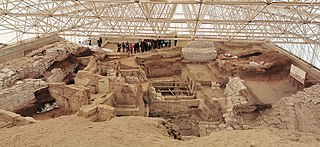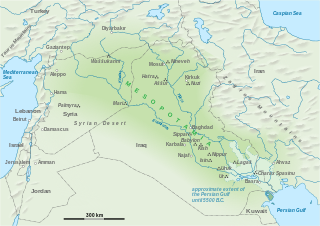
Çatalhöyük is a tell of a very large Neolithic and Chalcolithic proto-city settlement in southern Anatolia, which existed from approximately 7500 BC to 6400 BC, and flourished around 7000 BC. In July 2012, it was inscribed as a UNESCO World Heritage Site.

The Neolithic or New Stone Age is an archaeological period, the final division of the Stone Age in Europe, Asia and Africa. It saw the Neolithic Revolution, a wide-ranging set of developments that appear to have arisen independently in several parts of the world. This "Neolithic package" included the introduction of farming, domestication of animals, and change from a hunter-gatherer lifestyle to one of settlement. The term 'Neolithic' was coined by Sir John Lubbock in 1865 as a refinement of the three-age system.

The 9th millennium BC spanned the years 9000 BC to 8001 BC. In chronological terms, it is the first full millennium of the current Holocene epoch that is generally reckoned to have begun by 9700 BC. It is impossible to precisely date events that happened around the time of this millennium and all dates mentioned here are estimates mostly based on geological and anthropological analysis, or by radiometric dating.

In archaeology, a tell or tel, is an artificial topographical feature, a species of mound consisting of the accumulated and stratified debris of a succession of consecutive settlements at the same site, the refuse of generations of people who built and inhabited them, and of natural sediment.

The Hilly Flanks are the upland areas surrounding the Fertile Crescent of Southwest Asia, including the foothills of the Zagros Mountains, the Taurus Mountains, and the highland parts of the Levant. The Hilly Flanks foothill chain spans over 1000 miles, including parts of Turkey, northwestern Iraq, and western Iran. The region is just north of Mesopotamia, with similar characteristics of fertility with the added trait of foothills and plateaus.

The history of Mesopotamia ranges from the earliest human occupation in the Paleolithic period up to Late antiquity. This history is pieced together from evidence retrieved from archaeological excavations and, after the introduction of writing in the late 4th millennium BC, an increasing amount of historical sources. While in the Paleolithic and early Neolithic periods only parts of Upper Mesopotamia were occupied, the southern alluvium was settled during the late Neolithic period. Mesopotamia has been home to many of the oldest major civilizations, entering history from the Early Bronze Age, for which reason it is often called a cradle of civilization.

A proto-city is a large, dense Neolithic settlement that is largely distinguished from a city by its lack of planning and centralized rule. While the precise classification of many sites considered proto-cities is ambiguous and subject to considerable debate, common examples include Jericho, Çatalhöyük and the mega-sites of the Cucuteni-Trypillia culture. Sites of the Ubaid period in Mesopotamia have also been classed as proto-cities. These sites pre-date the Mesopotamian city-states of the Uruk period that mark the development of the first indisputable urban settlements, with the emergence of cities such as Uruk at the end of the Fourth Millennium, B.C.

Ganj Dareh is a Neolithic settlement in western Iran. It is located in the Harsin County in east of Kermanshah Province, in the central Zagros Mountains.

Aşıklı Höyük is a settlement mound located nearly 1 kilometre (0.62 mi) south of Kızılkaya village on the bank of the Melendiz brook, and 25 km (16 mi) southeast of Aksaray, Turkey. Aşıklı Höyük is located in an area covered by the volcanic tuff of central Cappadocia, in Aksaray Province. The archaeological site of Aşıklı Höyük was first settled in the Pre-Pottery Neolithic period, around 8,200 BC.

Ruth Tringham is an anthropologist, focusing on the archaeology of Neolithic Europe and southwest Asia. She is a Professor of the Graduate School (Anthropology) at the University of California, Berkeley and Creative Director and President of the Center for Digital Archaeology (CoDA), a recently established non-profit organization. Before going to Berkeley, she taught at Harvard University and University College London. Tringham is probably best known for her work at Selevac (1976–1979) and Opovo (1983–1989), Serbia, at the Eneolithic tell settlement of Podgoritsa, Bulgaria (1995), and at the well-known site of Çatalhöyük (1997-), Turkey.
Paul Goldberg is a geologist specializing in geomorphology and geoarchaeology who had done extensive worldwide field researches.
Hajji Firuz Tepe is an archaeological site located in West Azarbaijan Province in north-western Iran and lies in the north-western part of the Zagros Mountains. The site was excavated between 1958 and 1968 by archaeologists from the University of Pennsylvania Museum of Archaeology and Anthropology. The excavations revealed a Neolithic village that was occupied in the second half of the sixth millennium BC where some of the oldest archaeological evidence of grape-based wine was discovered in the form of organic residue in a pottery jar.

The prehistory of the Iranian plateau, and the wider region now known as Greater Iran, as part of the prehistory of the Near East is conventionally divided into the Paleolithic, Epipaleolithic, Neolithic, Chalcolithic, Bronze Age and Iron Age periods, spanning the time from the first settlement by archaic humans about a million years ago until the beginning of the historical record during the Neo-Assyrian Empire, in the 8th century BC.
Shahina Farid is a British archaeologist who is best known for her work as Field Director and Project Coordinator at the Neolithic site of Çatalhöyük in Turkey. She is currently the scientific dating coordinator for Historic England.
Georgina Herrmann, is a British retired archaeologist and academic, specialising in Near Eastern archaeology. Having worked as a civil servant, she later studied archaeology and spent the rest of her career as an active field archaeologist and lecturer. She was Reader in the Archaeology of Western Asia at University College London from 1994 to 2002.
Lisa-Marie Shillito is a British archaeologist and senior lecturer in landscape archaeology as well as director of the Wolfson Archaeology Laboratory and Earthslides at Newcastle University. Her practical work focuses on using soil micromorphology, phytolith analysis and geochemistry in order to understand human behaviour and landscape change. Her work includes the Neolithic settlements of Çatalhöyük in Turkey and Ness of Brodgar and Durrington Walls in Britain, but also Crusader castles and medieval settlements in Poland and the Baltic and in the Near East.

Bestansur is a Neolithic tell, or archaeological settlement mound, located in Sulaimaniyah province, Kurdistan Regional Government, Iraq in the western Zagros foothills. The site is located on the edge of the Shahrizor Plain, 30 km to the south-east of Sulaimaniyah. It is on the UNESCO World Heritage Tentative List.
Penny Bickle is Senior Lecturer in Archaeology at the University of York and her research focuses on daily routine in the Neolithic period.
Sara Perry is an archaeologist. Her research focuses on public archaeology and the use of digital media in archaeology and heritage. She is the Director of Research and Engagement at Museum of London Archaeology.
Jodie Lewis is a British archaeologist specialising in the study of prehistory. She is a lecturer at the University of Bradford. She was elected as a Fellow of the Society of Antiquaries of London in 2015. Before joining Bradford in 2022, Lewis lectured at the University of Wales, Bangor, the University of West of England, and the University of Worcester. She is a council member of The Prehistoric Society.












